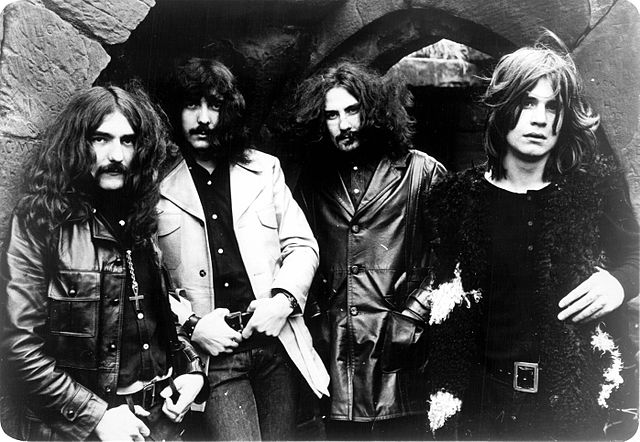
Black Sabbath in 1970
Black Sabbath’s debut album Black Sabbath was released almost 45 years ago in 1970, and alongside a couple of albums by Led Zeppelin and Deep Purple, this album is commonly cited as the beginning of heavy metal. ((For example, Robert Walser’s Running With The Devil: Power, Gender, and Madness in Heavy Metal Music (1993) gives this version of metal genesis on page 10.)) The standard story is that Ozzy Osbourne, Geezer Butler, Tony Iommi, and Bill Ward wanted to make a new kind of blues rock that would “scare people.” In addition the troubling question of why white British musicians would think of making contemplative and melancholic African American blues music into something primitive, dangerous, and aggressive, one of the mysteries surrounding the birth of heavy metal is: Why blues-rock and why the late 1960s?
It would take a book-length blog post to even try to answer that question completely, but even in a short post I can trace some important threads of the story. Now that they had assimilated African American blues and rock, white musicians in America and Britain were looking for exciting new ways to be groovy and bad. ((If you watch the first three episodes of the excellently-produced series Metal Evolution, quite a lot of the artists they interview talk about how redundant and formulaic blues and rock music had gotten by the late 1960s.)) The late 1960s and early 70s birthed a number of albums experimenting with taking blues and rock in different directions, by bands who later codified punk rock and heavy metal. The Stooges (later known as Iggy and the Stooges) released their debut The Stooges in 1969, which has in one album the psychedelic mantra of “We Will Fall,” the up-beat cowbell self-effacement of “I Wanna Be Your Dog,” and the creepily reverberant love song “Ann.” Judas Priest’s debut Rocka Rolla (1974) is just as much of a grab-bag as The Stooges, with some songs that sound like blues and some that sound a bit heavier, as well as a minute and a half of experimental guitar special effects during “Winter Retreat.” Both these bands seem to be feeling around in the dark in their debut albums, looking for something without really knowing what they’re after.
I have to wonder if Black Sabbath were in the same boat when they recorded their debut. Did they have a plan for the new style they wanted to create, or did it just sort of happen? Although the title track sounds like a radical vision of a new kind of music, Black Sabbath has plenty of blues in it still. ((Plenty of people have said this before — in fact, the folks over at Invisible Oranges have a great post that talks about all the blues elements on Black Sabbath.)) The band didn’t really consistently produce what we now think of as heavy metal music until their second album. Don’t get me wrong — Black Sabbath is an amazing album and I love it to pieces, and it definitely stands out from what other bands were doing at the end of the decade. But Black Sabbath hadn’t quite settled on the style that became heavy metal by the time they recorded their debut.
There is one infamous song “Black Sabbath,” sharing a name with both the album and the band itself, that doesn’t sound so bluesy. Fenriz, the drummer of the Norwegian band Darkthrone, pinpoints this song as the earliest precursor of black metal, principally because of its ludicrously simple tritone riff. ((As an outtake/extra for the film Until The Light Takes Us, Fenriz gives a 45 minute lecture about the history of black metal, beginning with this riff. He sings the tritone, and then explains, “when I make riffs, like for the last Darkthrone album, I still use those notes.”)) While it’s way out of proportion to say that Black Sabbath were trying to create black metal, there is something iconic about the song’s eerie sound, heavy pace, and devil-inspired lyrics. But although the lyrics to “Black Sabbath” certainly are dark, but are not really evil or Satanic as the lyrics of some later metal bands were; Cronos from the pioneering extreme metal band Venom complains about how Ozzy Osbourne would “sing about evil things and dark figures, then spoil it all by going ‘Oh God, help me!” at the end of the second verse. ((This version of the quote is from James Christopher Monger’s review of a Venom album at AllMusic. But Cronos has also said something similar on multiple other occasions, such as in this interview.)) Blues had a tradition of diabolical characters in songs long before Black Sabbath, and plenty of psychedelic rock songs in the 60s had dark, occult lyrics — a personal favorite is Strawberry Alarm Clock’s “Curse Of The Witches” — so Black Sabbath’s imagery on this song is not exactly unique.
It’s really the minimalism of “Black Sabbath” that stands out. The legendary riff has only three notes and the simplest possible rhythm. This sparse figure is repeated for four and a half bleak, soul-crushing minutes before there is finally a galloping second riff, which sort of just serves as a bridge into the guitar solo, after which the song ends with this great martial stomping bit. But more than two-thirds of the song is taken up by that haunting first riff, which seems to drag on and on.
This overwhelming simplicity isn’t anything like the metal that would be made in the next decade by Iron Maiden or Motorhead. In fact, it more closely resembles (in simplicity, in atmosphere, and in scale) The Stooges’ long psychedelic experiment “We Will Fall” than anything else in hard rock or heavy metal, at least until the advent of post-metal or ambient black metal in the 1990s. ((For those who don’t know The Stooges’ debut album very well, “We Will Fall” is 10 minutes of droning sitar and an endless mantra about the end of the world.)) Which is not to say that “Black Sabbath” didn’t inspire headbangers, but that just comparing it to the heavy metal it inspired doesn’t give the whole story. ((Andrew Cope’s book Black Sabbath and the Rise of Heavy Metal makes a very thorough comparison of Black Sabbath’s music to many varieties of later heavy metal, for those interested in finding out more.)) The whole story includes late-60s psychedelia, mind-expanding experiments in groovy riffing, and all sorts of bands breaking the mold of what rock had meant to the previous generation.
Black Sabbath – “Black Sabbath”
0.00 whole notes on a tubular bell, rain sounds
0.37 A x4 in powerchords, bass and guitar together, strong drum beat with snare
1.07 A' (in single notes, just one guitar, quiet pattern on toms and hihat) x2
1.23 A' x8 w/ vox Verse 1
2.19 A x4 with bells
2.50 A' x2
3.04 A' x8 w/ vox Verse 2
4.02 A x4
4.33 do…
4.38 B
x1 with out drumkit
x3 add drumkit
x16 add lyrics
5.17 C
x15 guitar solo
x1 different rhythm
6.16 ends with triplet rhythm


This seems like a pointless blog altogether to be honest try sitting down and picking up the artists autobiographies you will find that even black Sabbath themselves said that they wanted to create something to scare people in fact Ozzy even says that it is heavy blues if anything and doesn’t particularly like the term heavy metal to describe Sabbath or even his own work
I think it’s interesting to compare Sabbath and the Stooges. The Stooges’ Ann and We Will Fall definitely have similar vibes to the first Sabbath album, and they also pioneered the first heavy riffs. I wonder whether Sabbath were aware of them and liked them at the time – I wouldn’t be surprised.
And I’d really like to know whether the influence worked the other way round about 3 years later, when James Williamson wrote the riff for Raw Power. Was it inspired by Paranoid? There’s definitely a kinship between them.
Thanks for your comment, Rimbaud! Coincidentally, I was just reading a book this week which also suggests a connection between Sabbath and the Stooges, with reference to the same song you mentioned. I’ll paste the relevant passage here. The author, Evan Rapport, is arguing that punk evolved from a “raw power” transformation blues style by bands like the Stooges and the MC5, and then briefly mentions that heavy metal evolved from the same “raw power” style.
“As already noted, the raw power emphasis on riff-based blues picked up by early punk musicians was not unique but part of a wider trend among musicians in the 1960s, both black and white, in linking short-cycle blues resources to an authentic, rural, natural idea of blackness. Those musicians now considered to be antecedents of heavy metal, such as Black Sabbath and Led Zeppelin, emphasized the same blues features and could also be considered raw power examples.” 55
Rapport, Evan. 2020. Damaged: Musicality and Race in Early American Punk. Jackson, MI: University Press of Mississippi. https://www.upress.state.ms.us/Books/D/Damaged